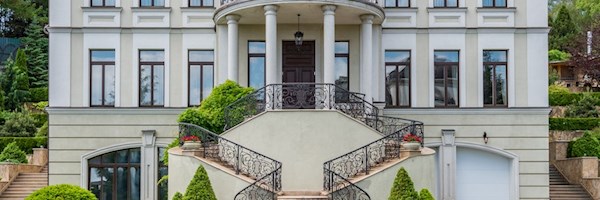Accessible garden design is something every homeowner should consider - whether accessibility is a priority or not for the garden's everyday users.
Gardens are often considered spaces to unwind, relax and escape to, so it makes sense that they should be physically accessible to everyone. Accessible garden design is also an essential consideration for futureproofing your home, ensuring you can enjoy your outdoor spaces even if your physical abilities are limited.
Specialist garden spaces for those with severe restrictions of movement or disability require careful planning, along with guidance from landscape professionals who specialise in this field. To ensure the safe use of the garden, you need to adhere to the regulations for ramps, have specialised equipment and correctly incorporate the necessary widths for mobility aids.
Levels
Consider ramps instead of garden steps for linking the different levels of your outdoor space. They will make access much easier for you and those with restricted mobility, ensuring everyone can use your garden. They will also facilitate moving gardening equipment such as lawnmowers and wheelbarrows.
- Ramps should have a gentle gradient – rising by no more than one metre over a distance of two metres. They take up slightly more space than steps but are much easier to navigate in all weather conditions. You can fit handrails along the length for added support.
- Level thresholds are important for connecting indoor and outdoor spaces to allow access for wheelchair users and decrease trip hazards. Using the same flooring material for interiors and exteriors will ensure this transition appears almost seamless.
- Create raised beds in preference to ground level planting. Beds should be built to a height of at least 500 mm. Raised beds will also allow you to import good quality sterilised soil, reducing the required weeding.
Paving
When planning new terraces or paved walkways, you should avoid loose aggregates, which are not easy to walk on or push wheelchairs or wheelbarrows over. Also to be avoided is porcelain paving. It is long lasting, but can become slippery - especially when wet.
Where possible, look for slightly textured paving:
- Cast concrete is practical but can sometimes age poorly.
- Natural stone and hardwearing slate will need an annual clean. However, if you select a ‘riven’ finish, the natural texture will be more robust underfoot and will keep its looks for many years.
Maintenance
Low maintenance garden practices are essential in accessible gardens. Reducing the physical strain of gardening can also create a space with long-lasting appeal.
Among the most labour-saving decisions you can make is to use weed control fabrics, mulch and install a watering system. These solutions can improve the longevity of your relationship with a garden and increase its usage for those with limited mobility.
Borders that consist primarily of shrubs will take a few years to establish, so without a weed control membrane, you will need to spend a lot of time weeding. Weed control fabric can be made from self-rotting material like paper or cardboard - best for organic gardening – or recycled materials like old carpeting. Once laid on the ground, it can be covered with bark or wood chips which are attractive and significantly reduce weeding.
An irrigation system may seem like a luxury, but it has been proven that a correctly installed and managed watering system can improve the growth rates of plants because it consistently provides the same volume of water - while reducing household water usage.
An irrigation system is a labour-saving device, but its initial investment is repaid over its lifespan through reduced water wastage and lower water bills.
Many systems are on the market - from specialist installations to self-installed leaky pipes and drip feeders. Research and ask questions in good garden centres and independent retailers to find a system that is right for your garden.
Plants
As a general rule, useful plants need to last for more than one season, especially in small spaces. For a labour-saving garden that is easy to live with and accessible, annuals are not ideal. Instead, plant hardy herbaceous perennials with long flowering seasons, such as pelargoniums, Gaura and Achillea. They don’t need staking or regular dead-heading, so labour requirements are minimal.
Small garden trees are ideal as they provide a habitat for birds and small animals, and many have flowers, autumn foliage colour and fruit. Some good choices include:
- Karee (Searsia lancea) - an indigenous tree with a graceful, weeping form and a softly rounded crown. It has no aggressive root system and occurs in all the provinces except KwaZulu-Natal. It has a low branching habit, producing multiple stems from ground level, but can be pruned into a single stemmed tree.
- Large Num-num (Carissa macrocarpa) - an ornamental evergreen shrub or small tree which grows wild along the KwaZulu-Natal and Eastern Cape coastlines. It endures wind, heat and salt spray and will tolerate moderate frost if planted in a protected position. It has dark green waxy leaves, and white, scented, star-shaped flowers, followed by edible bright red fruits.
- Pompom-tree (Dias cotinifolia) - can be single or multi-stemmed, with a round crown of bluish-green leaves and pink flowers. It has non-invasive roots and can be pruned to keep it small.
- For woody shrubs, choose the ones that have flowers, good autumn colour or are evergreen and have interesting shapes.
These garden design solutions will help you create a garden that is welcoming, easy to enjoy and with features that can adapt to your changing physical abilities.
Writer: Sarah-Jane Meyer
